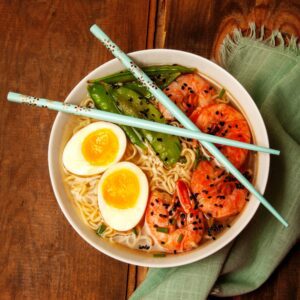Introduction
Few foods can compare to the hearty, savory delight that is ramen in terms of comfort food. Ramen is more than just a quick dinner; it’s an art form that originated in Japan and is now popular all over the world. We’ll delve deeply into the world of ramen in this essay, learning about its origins, varieties, and how to make the ideal bowl. Come along on this gastronomic journey with us, and get ready to enjoy every bite!
Background of Ramen
The word “ramen” has its roots in China, where it was first known as “lamian.” It wasn’t until the first decades of the 20th century that ramen reached Japan. It is now a staple of Japanese cuisine, with each region adding its own distinctive spin to this cherished delicacy.

Ramen varieties:
Shoyu Ramen 1.
The traditional soy-based ramen, or shoyu, is distinguished by its clear, dark-brown broth. It is soy sauce-seasoned, and green onions and bamboo shoots are frequently used as garnishes.
Miso Ramen 2.
Rich and filling broth derived from fermented soybean paste is a characteristic of miso ramen. It’s a common option for people who want a stronger flavor profile.
Tonkotsu Ramen 3.
Tonkotsu ramen is renowned for its rich broth made from pork. It is decadent and silky, and soft-boiled eggs and pieces of succulent chashu pig are frequently added on top.
Shio Ramen 4.
Compared to other types, Shio ramen delivers a broth that is lighter and saltier. It’s a fantastic choice for individuals who like a flavor that is more subdued.
How to Make the Ideal Ramen Bowl
- Start with the broth The broth is the foundation of every bowl of ramen. Take your time to simmer it to perfection, whether you’re preparing it from scratch or using a base you bought at the supermarket. It will develop more flavor the longer it cooks.
- Select Noodles Wisely
Different textures and thicknesses of ramen are available. Your ramen experience can be considerably impacted by the choice of noodles. While thicker noodles go nicely with richer, creamier broths, thinner noodles go well with lighter broths.
- Choose Your Own Toppings
Ramen’s adaptability is what makes it so appealing. Toppings can be changed to suit your preferences. Soft-boiled eggs, nori seaweed, bean sprouts, and corn are a few popular choices.
- Understand umami
Ramen depends on umami, the fifth taste experience. Use items like dried shiitake mushrooms, kombu seaweed, and bonito flakes to up the umami level.
The Culture of Ramen
Ramen is more than simply a food; it’s a phenomena in society. Even museums exist in Japan that are devoted to this famous dish. People from all walks of life congregate in ramen shops, or “ramen-ya,” to partake in this gastronomic marvel.
Conclusion
In summary, ramen is a trip through flavor, history, and culture rather than just a bowl of noodles. Ramen caters to all palates, whether you enjoy the soothing warmth of shoyu or the flavorful, rich broth of tonkotsu. So the next time you’re in the mood for a filling lunch, think about exploring the world of ramen. Your want for more will be sated by the experience.
FAQs
1. Is ramen healthy?
Ramen can be healthy if prepared with balanced ingredients. Opt for whole-grain noodles, lean protein, and plenty of vegetables for a nutritious bowl.
2. Can I make ramen at home?
Absolutely! With the right ingredients and a bit of patience, you can create restaurant-quality ramen in your kitchen.
3. What’s the best way to store leftover ramen?
Store ramen in an airtight container in the refrigerator. Reheat gently to maintain its deliciousness.
4. Are there vegetarian or vegan ramen options?
Yes, many ramen recipes cater to vegetarians and vegans. You can use vegetable broth and substitute meat with tofu or mushrooms for a meatless version.
